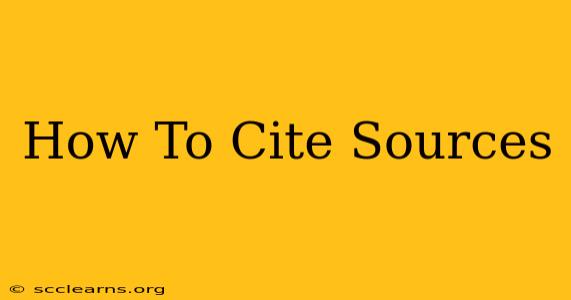Citing sources properly is crucial for academic integrity and avoiding plagiarism. Whether you're writing a research paper, essay, or even a simple blog post, understanding how to cite sources correctly is essential. This guide provides a comprehensive overview of different citation styles and best practices.
Understanding the Importance of Citation
Why bother with citations? Simply put, citing sources avoids plagiarism, a serious academic offense that can have severe consequences. Furthermore, proper citation:
- Gives credit where credit is due: Acknowledging the original creators of ideas and information shows respect for their work.
- Supports your arguments: Citations provide evidence for your claims, strengthening the credibility of your writing.
- Allows readers to verify your information: Providing sources enables readers to delve deeper into the topics you discuss.
- Enhances your credibility: Properly citing your sources demonstrates your academic rigor and attention to detail.
Common Citation Styles
Several different citation styles exist, each with its own specific rules and formatting. The most common include:
1. MLA (Modern Language Association)
MLA style is commonly used in the humanities, particularly in literature, languages, and cultural studies. It emphasizes author-page citations within the text and a "Works Cited" page at the end.
Example: (Smith 123).
2. APA (American Psychological Association)
APA style is frequently used in the social sciences, psychology, education, and business. It utilizes in-text citations with author, date, and page number (if applicable) and a "References" page listing the full bibliographic information.
Example: (Smith, 2023, p. 123).
3. Chicago/Turabian
This style has two main forms: notes and bibliography and author-date. The notes and bibliography style uses footnotes or endnotes and a bibliography, while the author-date style is similar to APA. It's often used in history, literature, and other humanities disciplines.
4. CSE (Council of Science Editors)
CSE style is widely used in scientific publications, especially in the natural sciences. It employs a numbered citation system with a reference list at the end.
Key Elements of a Citation
Regardless of the citation style you're using, most citations include these key elements:
- Author: The name of the person or organization responsible for the work.
- Date: The year the work was published or created.
- Title: The title of the work (book, article, website, etc.).
- Publication Information: Details about where the work was published (publisher, journal name, website URL, etc.).
Tips for Effective Citation Management
Managing your citations can be challenging, especially when dealing with multiple sources. Here are some helpful tips:
- Use citation management software: Tools like Zotero, Mendeley, and EndNote can help you organize your sources and generate citations automatically.
- Create a citation database early: Start compiling your citations as you research to avoid last-minute scrambling.
- Double-check your citations: Carefully review your citations before submitting your work to ensure accuracy.
- Consult style guides: Refer to the specific style guide's rules to avoid errors.
Avoiding Plagiarism: Best Practices
Beyond proper citation, understanding and avoiding plagiarism is critical. Remember that plagiarism includes not only copying text verbatim but also paraphrasing without proper attribution and using someone else's ideas without acknowledging the source. Always:
- Paraphrase carefully: Rephrase information in your own words, and cite the original source.
- Use quotation marks for direct quotes: Any direct quotes must be enclosed in quotation marks and properly cited.
- Cite all sources: Acknowledge all sources that contributed to your work, even if you only used a small portion of their information.
Conclusion
Mastering citation techniques is a vital skill for any student or researcher. By understanding the different citation styles and following best practices, you can ensure academic honesty, strengthen your arguments, and enhance the credibility of your work. Remember to always consult the specific style guide for detailed instructions and examples.

